|
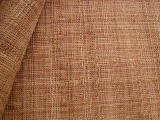 しな布の特徴はなんと言っても香り。ヨーロッパでは花をお茶にするくらいだから薬効もありそう。花は染めても優しい色合いが出ます。 The significant characteristic of the fabric made of linden bark is its fragrance.In Europe they make tea from its flowers.You can also use them for dyeing gentle pastel colours |
|
 しな布の特徴はなんと言っても香り。ヨーロッパでは花をお茶にするくらいだから薬効もありそう。花は染めても優しい色合いが出ます。 The significant characteristic of the fabric made of linden bark is its fragrance.In Europe they make tea from its flowers.You can also use them for dyeing gentle pastel colours |
| 工程 Process |
作業内容 Hows |
写真とコメント Photos and coments |
|
| 1 | 皮剥ぎ Stripping the bark |
6月の中旬から下旬に木を切り倒して樹皮をはぎ、次いで表皮をはぐ。 During the latter half of June the linden trees are cut down and the bark is stripped off. Furthermore the inner bark is separated from the outer one. |
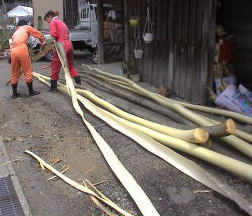 |
| 2 | 乾燥する Drying up |
||
| 3 | しな煮 Boiling |
円く巻いた皮と灰、水を入れ、10から12時間煮る。 The bark is wound in circle and boiled in the water with ash lye for 10-12 hours. |
|
| 4 | へぐれたてる Separating the bark |
さっと水洗いした後、一枚一枚うすくはがす。 After dipped in the water the layered bark is separated to some sheets. |
 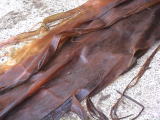 |
| 5 | しなこき Scraping off the skin |
川の中で繊維以外の不純物をこき取る。 The no-fibrous part of the skin is scraped off in the stream. |
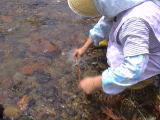 |
| 6 | 漬ける Soaking the sheet of fiber in the rice bran |
水と小糠の中に一昼夜漬け込む。 The fiber is soaked in the water with rice bran a whole day and night. |
|
| 7 | 洗う Washing |
水できれいに洗う。 The sheets of the fiber is washed in the water. |
|
| 8 | 乾燥する Drying up |
||
| 9 | しなさき Tearing the fiber appart |
幅広いしなを細く裂く。 The sheet of linden fiber is torn appart to narrow strings. |
|
| 10 | しな績み Ply-joining the fibers |
糸のつなぎ目(木の先に当たる部分)に爪で穴を開け、次の繊維(木jの根元に当たる部分)を差し込んで撚りこみ、繋いで、長い糸を作っていく。 Making a hole in the base-end (the upper part of the tree) of a string , the tip-end (the bottom patrt of the tree)of another string is inserted into thehole and they are twisted together to be connected.Thus a long string can be made. |
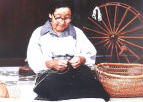 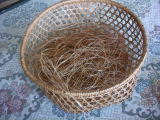 |
| 11 | へそかき Winding up the joined string |
たまった糸をひっくり返し、へそのような形に巻いていく。 The joined string is wound up to make an egg-like ball. |
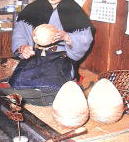 |
| 12 | しなより Twisting the string |
へそを湿らし、糸車で撚りを掛けていく。 The string is drawn from the egg-like ball to be twisted. |
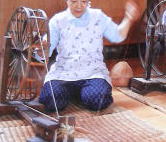 |
| 13 | 整経 Warping |
ここからは省略しますが、関川集落では整経台が地面に垂直に設置されていること、経糸に塗布する糊が近くの海から取ってきた海藻、いわゆるふのりであることが印象的でした。 I omitte the details about these processes.The unique items in the Sekikawa region are the vertical warping frame and the glue from seaweed. |
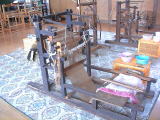 原始的な腰機と高機の中間に位置する地機。経糸は腰に括り付けられ、足を引くと綜絖が連動して上下します。人間と器械が一体化したような恍惚感を味わえる。腰で経糸の張りを調節できるので、糸の負担が少なく、ふんわりとした織り上がりになります。 原始的な腰機と高機の中間に位置する地機。経糸は腰に括り付けられ、足を引くと綜絖が連動して上下します。人間と器械が一体化したような恍惚感を味わえる。腰で経糸の張りを調節できるので、糸の負担が少なく、ふんわりとした織り上がりになります。The photo is the loom called "dgibata"of which function is between that of the primitive loom and the horizontal one.The warp is connected to the weaver's waist and the string that controls the heddles is tied to his/her foot. You will feel as if the loom and the human body were combined together.Actually the weaver can control the tention of the warp by his/her waist, so ther is less risk of snapping the warp.The woven fabric with the dgibata has a softer and more bulky touch. |
| 14 | 機がけ Setting the warp |
||
| 15 | 製織 Weaving |